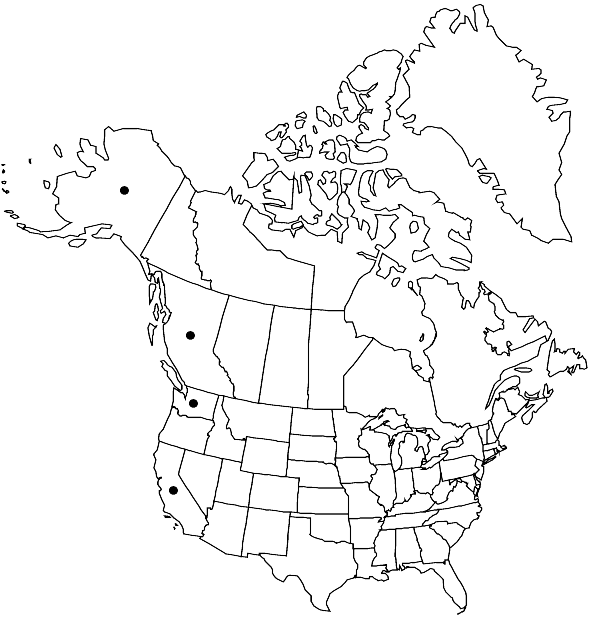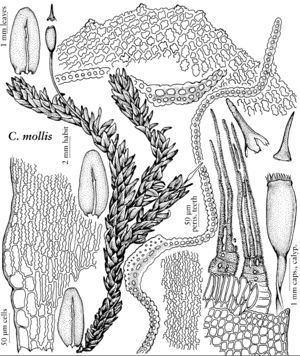Difference between revisions of "Codriophorus mollis"
in R. Ochyra et al., Cens. Cat. Polish Mosses, 141. 2003,.
FNA>Volume Importer |
imported>Volume Importer |
||
| (6 intermediate revisions by 2 users not shown) | |||
| Line 1: | Line 1: | ||
{{Treatment/ID | {{Treatment/ID | ||
|accepted_name=Codriophorus mollis | |accepted_name=Codriophorus mollis | ||
| − | |accepted_authority=(Cardot) Bednarek-Ochyra & Ochyra | + | |accepted_authority=(Cardot) Bednarek-Ochyra & Ochyra |
|publications={{Treatment/Publication | |publications={{Treatment/Publication | ||
|title=in R. Ochyra et al., Cens. Cat. Polish Mosses, | |title=in R. Ochyra et al., Cens. Cat. Polish Mosses, | ||
|place=141. 2003, | |place=141. 2003, | ||
}} | }} | ||
| − | |basionyms={{Treatment/ID/ | + | |basionyms={{Treatment/ID/Basionym |
|name=Racomitrium molle | |name=Racomitrium molle | ||
|authority=Cardot | |authority=Cardot | ||
| + | |rank=species | ||
| + | |publication_title=Bull. Herb. Boissier, sér. | ||
| + | |publication_place=2, 8: 333. 1908 | ||
}} | }} | ||
|synonyms= | |synonyms= | ||
| Line 24: | Line 27: | ||
|elevation=low to high elevations (0-2000 m) | |elevation=low to high elevations (0-2000 m) | ||
|distribution=B.C.;Alaska;Calif.;Wash.;South America (Colombia);e Asia. | |distribution=B.C.;Alaska;Calif.;Wash.;South America (Colombia);e Asia. | ||
| − | |discussion=<p>Codriophorus mollis is a circum-north-Pacific species, ranging from Japan and Kamchatka across the Aleutian arc to northwestern North America, and with a highly disjunct locality in the paramo of the northern Andes of Colombia. In North America its main center of occurrence is in British Columbia, with some stations in northern California. It is closely related to C. acicularis but differs in the fairly soft texture of the plants, which are often almost unbranched and thread-like with a characteristic “calliergonoid” appearance owing to the imbricate foliage of broadly elliptical, lingulate, or ovate to oblong or oblong-elliptical leaves with very broadly rounded-obtuse, entire or faintly erose-dentate apices. Moreover, the costa is slender, commonly spurred, and regularly forked at the apex, with one branch much longer and more slender, extending higher up the leaf than the other, usually reaching half or three quarters of the way up the leaf. The costa of C. mollis is similar to that in C. aduncoides, except for being more slender, 75–100 µm wide near the base in the former versus (80–)90–180(–220) µm wide in the latter. Moreover, the leaf apex in C. aduncoides is often subacute and tubular owing to inflexed margins and is remotely bluntly or sharply dentate to erose-dentate.</p> | + | |discussion=<p><i>Codriophorus mollis</i> is a circum-north-Pacific species, ranging from Japan and Kamchatka across the Aleutian arc to northwestern North America, and with a highly disjunct locality in the paramo of the northern Andes of Colombia. In North America its main center of occurrence is in British Columbia, with some stations in northern California. It is closely related to <i>C. acicularis</i> but differs in the fairly soft texture of the plants, which are often almost unbranched and thread-like with a characteristic “calliergonoid” appearance owing to the imbricate foliage of broadly elliptical, lingulate, or ovate to oblong or oblong-elliptical leaves with very broadly rounded-obtuse, entire or faintly erose-dentate apices. Moreover, the costa is slender, commonly spurred, and regularly forked at the apex, with one branch much longer and more slender, extending higher up the leaf than the other, usually reaching half or three quarters of the way up the leaf. The costa of <i>C. mollis</i> is similar to that in <i>C. aduncoides</i>, except for being more slender, 75–100 µm wide near the base in the former versus (80–)90–180(–220) µm wide in the latter. Moreover, the leaf apex in <i>C. aduncoides</i> is often subacute and tubular owing to inflexed margins and is remotely bluntly or sharply dentate to erose-dentate.</p> |
|tables= | |tables= | ||
|references= | |references= | ||
| Line 33: | Line 36: | ||
-->{{#Taxon: | -->{{#Taxon: | ||
name=Codriophorus mollis | name=Codriophorus mollis | ||
| − | + | |authority=(Cardot) Bednarek-Ochyra & Ochyra | |
| − | |authority=(Cardot) Bednarek-Ochyra & Ochyra | ||
|rank=species | |rank=species | ||
|parent rank=section | |parent rank=section | ||
| Line 47: | Line 49: | ||
|publication year= | |publication year= | ||
|special status= | |special status= | ||
| − | |source xml=https:// | + | |source xml=https://bitbucket.org/aafc-mbb/fna-data-curation/src/2e0870ddd59836b60bcf96646a41e87ea5a5943a/coarse_grained_fna_xml/V27/V27_407.xml |
|subfamily=Grimmiaceae subfam. Racomitrioideae | |subfamily=Grimmiaceae subfam. Racomitrioideae | ||
|genus=Codriophorus | |genus=Codriophorus | ||
Latest revision as of 21:26, 5 November 2020
Plants usually fairly soft, olivaceous, brown or yellow-, rusty orange to blackish brown, sometimes dirty olive yellow, golden to blackish green distally, brown to blackish brown proximally, sometimes brown, blackish brown to jet throughout. Stems 1–7(–10) cm tall. Leaves closely appressed and imbricate, erect, secund, erect-spreading to patent when dry, concave to cochleariform, broadly ovate, lingulate, elliptic, oblong or oblong-elliptic, (1.5–)2–2.5(–2.8) × 0.9–1.2 mm; margins 1-stratose, entire to subentire at the apex; apices very broadly rounded-obtuse and usually cucullate; costa ceasing at 1/2–3/4 of the way up the leaf, spurred and commonly forked at the apex, 75–100 µm wide at the base; laminal cells 1-stratose. Inner perichaetial leaves hyaline or with several thick-walled cells at the extreme apex or chlorophyllous throughout. Seta dark brown becoming black with age, fairly stout, 4–9 mm long. Capsule light to dark brown, obloid to shortly cylindric, 1.2–2 × 0.7–0.8 mm; peristome teeth lanceolate, 400–425 µm long, reddish brown, densely spiculate-papillose throughout, divided nearly to the base into 2, or often imperfectly into 3 terete, rather unequal prongs. Spores (13–)17–20 µm.
Habitat: Wet cliffs, dripping rocks, splashed or periodically flooded boulders, stones and outcrops in creek beds and the margins of watercourses, seepy sloping outcrops on roadsides and thin soil over moist rock ledges, in open and insolated as well as in diffusely lit and shaded sites on both acidic and basic substrates, scattered throughout coastal coniferous forests and in subalpine meadows and bogs
Elevation: low to high elevations (0-2000 m)
Distribution

B.C., Alaska, Calif., Wash., South America (Colombia), e Asia.
Discussion
Codriophorus mollis is a circum-north-Pacific species, ranging from Japan and Kamchatka across the Aleutian arc to northwestern North America, and with a highly disjunct locality in the paramo of the northern Andes of Colombia. In North America its main center of occurrence is in British Columbia, with some stations in northern California. It is closely related to C. acicularis but differs in the fairly soft texture of the plants, which are often almost unbranched and thread-like with a characteristic “calliergonoid” appearance owing to the imbricate foliage of broadly elliptical, lingulate, or ovate to oblong or oblong-elliptical leaves with very broadly rounded-obtuse, entire or faintly erose-dentate apices. Moreover, the costa is slender, commonly spurred, and regularly forked at the apex, with one branch much longer and more slender, extending higher up the leaf than the other, usually reaching half or three quarters of the way up the leaf. The costa of C. mollis is similar to that in C. aduncoides, except for being more slender, 75–100 µm wide near the base in the former versus (80–)90–180(–220) µm wide in the latter. Moreover, the leaf apex in C. aduncoides is often subacute and tubular owing to inflexed margins and is remotely bluntly or sharply dentate to erose-dentate.
Selected References
None.
